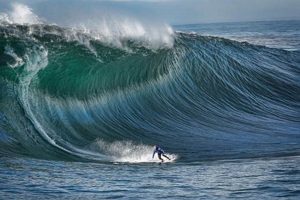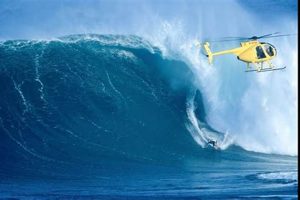The pursuit of riding the largest ocean swells represents a pinnacle of athletic achievement and a testament to human courage. Successfully navigating such immense forces of nature demands exceptional skill, physical prowess, and a deep understanding of ocean dynamics. The feat involves confronting unpredictable variables, requiring split-second decision-making and unwavering focus. For example, scaling a wave exceeding 100 feet in height exemplifies this ambition.
The significance of conquering massive waves extends beyond individual accomplishment. It pushes the boundaries of what is considered physically possible, inspiring awe and respect for the ocean’s power. Historical attempts and successes contribute valuable data to oceanographic research, aiding in the prediction and understanding of extreme weather events. Furthermore, these endeavors fuel innovation in surfing equipment and safety protocols, benefiting the broader surfing community.
This article will delve into the specific locations known for producing colossal swells, the techniques and equipment utilized by elite surfers, and the inherent risks associated with challenging such monumental waves. Furthermore, it will examine the criteria used to measure wave height and the ongoing debate surrounding record-breaking achievements in this extreme sport.
Tips for Addressing Immense Waves
Navigating exceptionally large waves requires meticulous preparation, specialized equipment, and a profound understanding of ocean conditions. These tips emphasize safety, technique, and the critical factors involved in confronting such formidable forces.
Tip 1: Prioritize Comprehensive Training: Physical conditioning is paramount. Develop exceptional cardiovascular endurance, leg strength, and breath-holding capabilities. Consistent training mitigates the risk of exhaustion and facilitates quick decision-making under pressure.
Tip 2: Employ Specialized Equipment: Utilize a surfboard specifically designed for large wave riding. This typically includes increased length, thickness, and reinforcement to withstand the immense forces. A personal flotation device (PFD) and impact suit are essential for enhanced safety.
Tip 3: Analyze Weather and Swell Patterns: Thoroughly research weather forecasts and swell models to understand the predicted wave size, period, and direction. Identifying potential hazards, such as rogue sets or unpredictable currents, is crucial.
Tip 4: Establish Water Safety Protocols: Communicate clearly with support teams, including jet ski operators and lifeguards. Develop predefined rescue plans and hand signals to ensure efficient assistance in emergency situations. Regular safety drills are recommended.
Tip 5: Practice Tow-In Techniques: Tow-in surfing allows for accessing waves that are too fast or large to paddle into. Master the communication and coordination required between the surfer and the jet ski driver. Emphasize controlled entry and exit from the wave.
Tip 6: Maintain Calm and Focus: Approaching an immense wave requires a calm and focused mindset. Employ mental techniques, such as visualization and deep breathing exercises, to manage anxiety and maintain composure under pressure. React decisively based on observation and experience.
Tip 7: Understand Wave Dynamics: Develop a deep understanding of how large waves break and the associated currents. Identify the optimal line to take and anticipate potential hazards. Recognizing the wave’s energy distribution aids in maintaining control.
Adherence to these guidelines significantly increases the chances of safely and successfully navigating large waves. Respect for the ocean’s power and a commitment to rigorous preparation are essential prerequisites.
The subsequent sections will further explore the specific techniques and strategies employed by experienced big wave surfers, offering additional insights into this demanding pursuit.
1. Preparation
Confronting the largest waves necessitates meticulous preparation across multiple domains. The scale of the challenge demands a comprehensive approach, mitigating risk and maximizing the potential for success in an environment characterized by unpredictable and extreme forces.
- Physical Conditioning
Sustained exertion under immense pressure requires exceptional physical fitness. Cardiovascular endurance, muscular strength (particularly in the legs and core), and flexibility are essential. Training regimens must simulate the demands of big wave surfing, incorporating exercises that build resilience and enhance recovery capabilities. Failure to adequately prepare physically increases the likelihood of fatigue-related errors and injury.
- Mental Fortitude
Maintaining composure in high-pressure situations is critical. Big wave surfing demands unwavering focus and the ability to make split-second decisions. Mental training techniques, such as visualization and mindfulness, can enhance stress management and improve decision-making under extreme conditions. A lack of mental preparedness can lead to panic, impaired judgment, and increased risk of injury or fatality.
- Equipment Proficiency
Familiarity with and proper maintenance of specialized equipment are non-negotiable. Surfers must be intimately acquainted with their boards, leashes, personal flotation devices (PFDs), and any other safety gear. Regular equipment checks and practice sessions are essential to ensure optimal performance and reliability. Malfunctioning or improperly used equipment can significantly compromise safety and reduce the likelihood of success.
- Environmental Awareness
A deep understanding of ocean dynamics and local conditions is crucial. Surfers must be able to interpret weather forecasts, swell patterns, and tidal influences. Knowledge of local currents, reef formations, and potential hazards is paramount. Ignoring environmental cues or demonstrating a lack of awareness can lead to miscalculations, increased exposure to danger, and compromised safety.
The interconnectedness of these preparation facets underscores the importance of a holistic approach. Deficiencies in any area can compromise the entire endeavor. The pursuit of riding the largest waves demands a commitment to rigorous and comprehensive preparation, recognizing that success is contingent upon physical prowess, mental resilience, equipment reliability, and environmental awareness.
2. Equipment
Successfully navigating the most immense ocean waves hinges significantly on specialized equipment. The extreme forces and inherent risks demand gear engineered to withstand unprecedented stress and enhance surfer safety. This equipment is not merely an accessory but an integral component in the pursuit.
- Specialized Surfboards
Standard surfboards are inadequate for tackling waves exceeding significant heights. Big wave boards are longer, thicker, and heavier, providing increased stability and paddling power. Materials such as high-density foam cores and reinforced fiberglass or carbon fiber laminates enhance structural integrity. These boards are designed to maintain speed and control in conditions where conventional boards would fail. An example is the use of specific boards with increased volume and length designed specifically for the conditions at Nazar, Portugal, by many prominent big wave surfers.
- Personal Flotation Devices (PFDs)
In the event of a wipeout, a PFD can be the difference between survival and catastrophe. These devices provide buoyancy, aiding the surfer in resurfacing quickly and conserving energy. Advanced PFDs often incorporate inflation systems and integrated communication devices, allowing surfers to signal for assistance. The use of such devices has become standard practice, significantly improving safety in big wave surfing.
- Impact Suits
The force of a breaking wave can cause severe injuries. Impact suits, constructed from high-density foam and protective materials, mitigate the effects of collisions with the water surface or submerged objects. These suits offer crucial protection for the torso, limbs, and vital organs, reducing the risk of serious trauma. Many big wave surfers now routinely use these suits as part of their essential gear.
- Tow-In Systems
For waves that are too fast or large to paddle into, tow-in surfing techniques are employed. This involves a jet ski towing the surfer into the wave, enabling them to reach the necessary speed and positioning. The jet ski also serves as a rescue vehicle in the event of a wipeout. The effectiveness of tow-in systems relies on precise coordination between the surfer and the driver and is a critical aspect of confronting certain massive waves.
The evolution of equipment has been instrumental in pushing the boundaries of what is possible in big wave surfing. As surfers continue to challenge increasingly larger waves, innovation in equipment design and technology will remain crucial. These advancements not only enhance performance but also significantly improve the safety and survivability of those who dare to challenge these formidable forces of nature.
3. Conditions
The feasibility of riding the largest waves is intrinsically linked to specific environmental conditions. The generation of these colossal swells requires a convergence of meteorological and oceanic factors that dictate wave size, shape, and predictability. Wind speed and duration, fetch (the distance over which the wind blows), and bathymetry (the underwater topography) are all critical determinants. These elements must align to create waves of sufficient magnitude and form suitable for surfing.
For instance, the infamous Cortes Bank, located off the coast of California, exemplifies this dependency. Its unique underwater seamount abruptly rises from the deep ocean floor, causing incoming swells to refract and converge, creating exceptionally large waves. However, these conditions are only realized when powerful storms generate significant wave energy in the North Pacific Ocean, which subsequently travels thousands of miles to reach the bank. Nazare, Portugal, offers another compelling example, where a deep underwater canyon focuses wave energy, resulting in some of the tallest rideable waves on Earth. Without the specific canyon topography and the powerful North Atlantic storms, Nazare would not be recognized as a big wave surfing location. Therefore, understanding the specific geographic and meteorological factors is key for surfer.
In summary, attempting to ride the largest waves necessitates an intimate understanding of the interplay between meteorological forces and oceanographic features. The confluence of specific conditions, often rare and unpredictable, is the essential precursor to these extraordinary feats. The ability to accurately forecast and interpret these conditions is as crucial as physical skill and specialized equipment. This dependency underscores the inherent challenge and inherent risk of big wave surfing, as well as highlighting the respect that must be paid to the immense power of the ocean.
4. Technique
The ability to successfully navigate extremely large waves hinges critically on mastering specialized techniques. These techniques are not merely adaptations of conventional surfing but represent a distinct skill set honed through years of experience and rigorous training. Without precise execution, confronting such formidable forces becomes exponentially more dangerous.
- Reading the Wave
Accurately assessing the wave’s trajectory and energy distribution is paramount. This involves identifying the peak, the shoulder, and potential hazards such as boils or rogue sections. Experienced surfers develop an intuitive understanding of wave dynamics, enabling them to anticipate changes and make informed decisions regarding positioning and trajectory. Misreading the wave can lead to being caught inside, resulting in a potentially catastrophic wipeout.
- Controlled Takeoff
The takeoff is the most critical moment. Positioning oneself correctly and committing to the drop requires precise timing and balance. Utilizing tow-in techniques, where a jet ski pulls the surfer into the wave, demands seamless coordination between the surfer and the driver. A botched takeoff can result in a freefall from a significant height, increasing the risk of severe injury. Furthermore, a controlled takeoff is a fundamental prerequisite for riding a big wave.
- Maintaining Balance and Control
Once on the wave, maintaining balance and control is essential for navigating the immense forces at play. This involves utilizing subtle shifts in weight and body positioning to counteract the wave’s pull. Employing a deep, athletic stance and engaging the core muscles are crucial for stability. Loss of balance can lead to a wipeout, exposing the surfer to the full force of the wave.
- Wipeout Survival
Despite best efforts, wipeouts are inevitable. Knowing how to survive a wipeout is a critical skill. This involves protecting the head and neck, relaxing the body to minimize injury, and understanding how to utilize personal flotation devices effectively. Conserving oxygen and maintaining awareness of the wave’s movement are also crucial. Improper wipeout technique can result in prolonged submersion, disorientation, and increased risk of drowning.
These techniques, honed through years of dedicated practice and experience, are indispensable for confronting the largest waves. Mastering these skills transforms the seemingly impossible into a feat of athleticism and courage. The continuous refinement and adaptation of these techniques are essential for pushing the boundaries of what is achievable in big wave surfing and are a key factor when assessing “surf biggest wave ever”.
5. Risk
The pursuit of riding the largest ocean waves is inherently intertwined with substantial risk. The extreme forces exerted by these waves, coupled with the unpredictable nature of the ocean environment, create a high-stakes scenario where the potential for serious injury or fatality is ever-present. The increased scale magnifies this risk due to the elevated physical demand and the potential for catastrophic consequences. For example, a fall from such a height can result in severe impact with the water surface, leading to broken bones, concussions, or internal injuries. The prolonged periods of submersion after a wipeout also pose a significant threat, as the force of the wave can hold a surfer underwater, leading to oxygen deprivation and potential drowning.
Understanding and mitigating these risks is paramount for anyone attempting to ride the largest waves. This involves meticulous planning, thorough preparation, and a deep respect for the power of the ocean. Proper training, specialized equipment, and experienced support teams are all crucial elements in minimizing the inherent dangers. Furthermore, risk assessment is constantly evolving, as big wave surfers learn from past incidents and adapt their strategies and equipment accordingly. Instances of severe injuries and, unfortunately, fatalities serve as somber reminders of the ever-present dangers involved.
In conclusion, the element of risk is inextricably linked to the pursuit of riding the largest waves. It is not something to be ignored or underestimated, but rather a factor that must be carefully considered and mitigated through rigorous preparation, advanced equipment, and a profound understanding of the ocean environment. While the rewards of successfully confronting these monumental waves can be significant, they must be weighed against the inherent and undeniable risks involved, leading to a respect for the ocean’s capabilities.
6. Record
The concept of “Record” occupies a central position in the pursuit of riding the largest waves, serving as both a benchmark of achievement and a catalyst for ongoing innovation. The desire to establish a new record drives surfers to push the boundaries of what is considered possible, prompting advancements in technique, equipment, and risk assessment.
- Measurement Criteria
Establishing a definitive record necessitates clear and objective measurement criteria. Wave height is typically determined using photographic or video evidence, often employing triangulation techniques to estimate the size of the wave relative to the surfer. However, variations in wave shape and viewing angles can introduce subjectivity and controversy. Standardizing measurement protocols is an ongoing challenge, with various organizations proposing different methods. The absence of a universally accepted standard complicates the process of definitively declaring a new record.
- Verification Process
Claiming a record requires rigorous verification by a panel of experts. This panel typically consists of experienced surfers, oceanographers, and photographers who analyze the available evidence and assess the validity of the claim. The verification process can be lengthy and complex, often involving detailed analysis of wave dynamics, weather conditions, and surfer performance. The credibility of the verification process is crucial for maintaining the integrity of the record.
- Technological Advancements
Technological advancements have played a significant role in the pursuit of record-breaking waves. Improved weather forecasting models allow surfers to anticipate and prepare for significant swell events. Advanced surfboard designs and materials enhance performance and safety. High-resolution cameras and video equipment provide detailed documentation of wave size and surfer performance. These technological advancements enable surfers to push the boundaries of what is possible and provide more accurate data for record verification.
- Historical Context
The history of big wave surfing is punctuated by a series of record-breaking achievements. Each new record represents a significant milestone, reflecting advancements in surfing technique, equipment, and risk assessment. Analyzing the historical progression of record wave heights provides valuable insights into the evolution of big wave surfing and the ongoing quest to conquer the ocean’s most formidable forces. Every successful ride adds to the historical narrative, inspiring future generations of surfers.
These elements intertwine to create a framework for understanding the significance of “Record” in the context of riding the largest waves. While the quest for a new record fuels innovation and inspires awe, it also underscores the inherent challenges of measurement, verification, and the constant need to refine these processes. The continuing drive to “surf biggest wave ever” will invariably involve setting new marks and re-evaluating the standards by which those achievements are measured.
7. Courage
The act of attempting to ride the largest ocean waves demands a profound level of courage, functioning not merely as a desirable trait but as an essential prerequisite for participation. The scale of the undertaking necessitates confronting quantifiable dangers, encompassing the potential for physical injury, prolonged submersion, and the psychological stress induced by facing overwhelming natural forces. This courage is not the absence of fear, but rather the calculated decision to act in the face of it, underpinned by rigorous preparation and a realistic assessment of risk.
Courage, in this context, manifests in several crucial aspects. It empowers a surfer to commit to a takeoff on a wave of immense size, a commitment that often cannot be reversed. It enables the individual to maintain composure during a wipeout, where the instinct to panic must be suppressed in favor of executing practiced survival techniques. Furthermore, it fosters the resilience necessary to persevere after setbacks, including injuries or near-drowning experiences. Examples such as Laird Hamilton’s pioneering tow-in surfing at Teahupo’o and Garrett McNamara’s record-breaking ride at Nazar illustrate this courage in action, where calculated risk-taking was coupled with exceptional skill to achieve unprecedented feats. Such bravery fuels innovation, driving the development of new techniques and equipment that redefine the limits of the sport.
The understanding of the courage component is of importance when analyzing “surf biggest wave ever,” as it is directly proportional to the likelihood of facing increased hazards. A deficit in courage, whether stemming from inadequate mental preparation or an underestimation of the ocean’s power, can compromise decision-making and increase the chances of catastrophic outcome. Therefore, the courage required to confront these waves must be viewed as a skill to be cultivated, honed, and rigorously tested. While the romanticized image of the fearless surfer may exist, it is the calculated bravery of those who acknowledge the inherent dangers, prepare meticulously, and act decisively that defines true courage in this extreme endeavor.
Frequently Asked Questions About Riding Enormous Ocean Swells
This section addresses common inquiries regarding the pursuit of riding exceptionally large waves, providing clarity on key aspects and dispelling potential misconceptions.
Question 1: What defines a “big wave”?
While subjective, waves exceeding 20 feet in height, measured from trough to crest, are generally considered large. However, wave period, shape, and breaking characteristics also contribute to the perception of size and the overall challenge.
Question 2: Where are some of the most renowned locations for big wave surfing?
Notable locations include Nazar, Portugal; Jaws (Peahi), Hawaii; Mavericks, California; and Teahupo’o, Tahiti. Each location presents unique challenges due to specific wave characteristics and environmental conditions.
Question 3: What specialized equipment is essential for big wave surfing?
Essential equipment includes a specialized surfboard designed for large wave riding, a personal flotation device (PFD), an impact suit, and potentially a tow-in system involving a jet ski and rope.
Question 4: What are the primary risks associated with big wave surfing?
The primary risks include severe injuries resulting from falls, prolonged submersion and potential drowning, and collisions with submerged objects. The extreme forces exerted by large waves pose a significant threat.
Question 5: How is wave height accurately measured in big wave surfing?
Wave height measurement typically involves photographic or video analysis, often utilizing triangulation techniques to estimate the wave’s size relative to the surfer. Standardization of measurement protocols remains an ongoing challenge.
Question 6: What role does a support team play in big wave surfing?
A support team, including jet ski operators, lifeguards, and spotters, is crucial for safety. They provide assistance during tow-in maneuvers, perform rescues in the event of wipeouts, and monitor environmental conditions.
The pursuit of riding exceptionally large waves involves significant challenges and inherent risks. Understanding these aspects is essential for appreciating the skill, courage, and preparation required by big wave surfers.
The following section will summarize the key takeaways from this article.
Concluding Assessment
This exploration of conquering monumental ocean swells has highlighted the confluence of factors crucial to such an endeavor. Physical preparation, specialized equipment, a keen understanding of ocean conditions, refined technique, and an acceptance of inherent risks are all indispensable elements. The desire to “surf biggest wave ever” necessitates constant innovation in safety protocols, equipment design, and wave forecasting methodologies. The inherent challenges of wave measurement and verification underscore the need for standardized practices and objective assessment criteria.
The pursuit of riding the largest waves stands as a testament to human ambition and the unwavering quest to push the boundaries of physical and mental capabilities. Continued advancements in technology, combined with the courage and dedication of big wave surfers, will undoubtedly lead to further milestones. A continued focus on safety and responsible exploration will be paramount as future generations continue to challenge the ocean’s most formidable forces.







